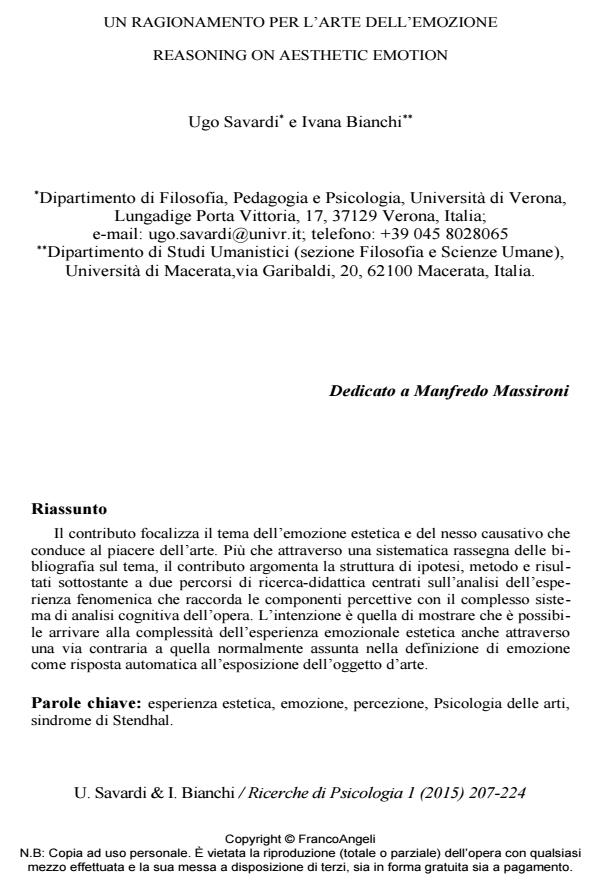Reasoning on aesthetic emotion
Journal title RICERCHE DI PSICOLOGIA
Author/s Ugo Savardi, Ivana Bianchi
Publishing Year 2015 Issue 2015/1 Language Italian
Pages 18 P. 2017-224 File size 273 KB
DOI 10.3280/RIP2015-001013
DOI is like a bar code for intellectual property: to have more infomation
click here
Below, you can see the article first page
If you want to buy this article in PDF format, you can do it, following the instructions to buy download credits

FrancoAngeli is member of Publishers International Linking Association, Inc (PILA), a not-for-profit association which run the CrossRef service enabling links to and from online scholarly content.
The paper focuses on aesthetic emotions and the causative link that leads to a work of art being seen as pleasing or otherwise to an observer. Rather than proposing a systematic review of the literature on the subject, the paper presents the hypotheses, methods and results related to two different research and educational projects carried out by the authors. These concern the phenomenal experience that connects the perceptual analysis of a work of art to the complex cognitive analysis which underlies it. The aim is to demonstrate, in contrast to the popular line of thought that aesthetic emotions are automatic responses to a work of art, that people may experience aesthetic emotions as the result of the process they go through in order to understand that which can be observed in the artwork.
Keywords: Aesthetic experience, emotion, perception, Psychology of arts, Stendhal’s syndrome.
- Johnson-Laird, P., & Oatley, K. (1992). Basic emotions, rationality, and folk theory. Cognition & Emotion, 6(3-4), 201-223.
- Kubovy, M. (1999) On the Pleasure of the Mind. In D. Kahneman, E. Diener, & N. Schwarz (Eds.), Well-Being: Foundations of Hedonic Psychology (pp. 134-154). Russel Sage Foundation. New York.
- Luccio, R. (2012). Per una storia della psicometria delle emozioni. In: R. Rumiati, a cura di: Pensiero Azione Emozione. Scritti in onore di Paolo Legrenzi (pp. 187-205). Bologna: il Mulino.
- Michell, J. (1997). Quantitative science and the definition of measurement in psychology. British Journal of Psychology, 88, 355-3.
- Michell, J. (2008). Is Psychometrics Pathological Science? Measurement: Interdisciplinary Research and Perspectives, 6(1-2), 7-24.
- Plutchik, R. (1992). The Nature of Emotion. American Scientist, 89, 344-350.
- Stendhal (1974). Roma, Napoli e Firenze. Viaggio in Italia da Milano a Reggio Calabria. Roma-Bari: Laterza.
- Trendler, G. (2009) Measurement Theory, Psychology and the Revolution that Cannot Happen. Theory & Psychology, 19(5), 579-599.
Ugo Savardi, Ivana Bianchi, Un ragionamento per l’arte dell’emozione in "RICERCHE DI PSICOLOGIA " 1/2015, pp 2017-224, DOI: 10.3280/RIP2015-001013